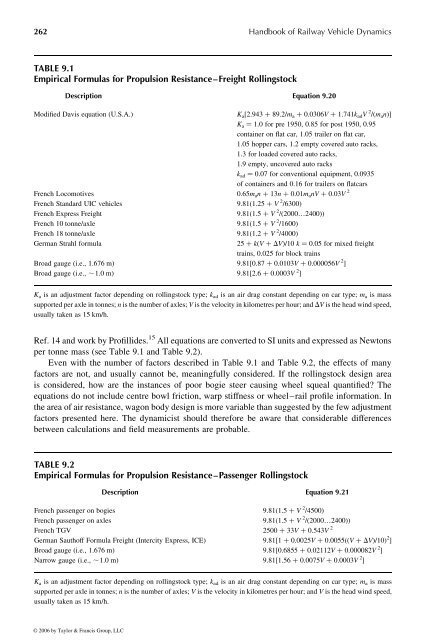Hi-Res PDF - CRCnetBASE
Hi-Res PDF - CRCnetBASE
Hi-Res PDF - CRCnetBASE
Create successful ePaper yourself
Turn your PDF publications into a flip-book with our unique Google optimized e-Paper software.
262<br />
TABLE 9.1<br />
Empirical Formulas for Propulsion <strong>Res</strong>istance–Freight Rollingstock<br />
Description Equation 9.20<br />
Modified Davis equation (U.S.A.) K a [2.943 þ 89.2/m a þ 0.0306V þ 1.741k adV 2 /(m a n )]<br />
K a ¼ 1.0 for pre 1950, 0.85 for post 1950, 0.95<br />
container on flat car, 1.05 trailer on flat car,<br />
1.05 hopper cars, 1.2 empty covered auto racks,<br />
1.3 for loaded covered auto racks,<br />
1.9 empty, uncovered auto racks<br />
k ad ¼ 0.07 for conventional equipment, 0.0935<br />
of containers and 0.16 for trailers on flatcars<br />
French Locomotives 0.65m a n þ 13n þ 0.01m a nV þ 0.03V 2<br />
French Standard UIC vehicles 9.81(1.25 þ V 2 /6300)<br />
French Express Freight 9.81(1.5 þ V 2 /(2000…2400))<br />
French 10 tonne/axle 9.81(1.5 þ V 2 /1600)<br />
French 18 tonne/axle 9.81(1.2 þ V 2 /4000)<br />
German Strahl formula 25 þ k ( V þ D V )/10 k ¼ 0.05 for mixed freight<br />
trains, 0.025 for block trains<br />
Broad gauge (i.e., 1.676 m) 9.81[0.87 þ 0.0103V þ 0.000056V 2 ]<br />
Broad gauge (i.e., , 1.0 m) 9.81[2.6 þ 0.0003V 2 ]<br />
K a is an adjustment factor depending on rollingstock type; k ad is an air drag constant depending on car type; m a is mass<br />
supported per axle in tonnes; n is the number of axles; V is the velocity in kilometres per hour; and D V is the head wind speed,<br />
usually taken as 15 km/h.<br />
Ref. 14 and work by Profillides. 15 All equations are convertedtoSIunits and expressedasNewtons<br />
per tonne mass (see Table 9.1 and Table 9.2).<br />
Even with the number of factors described in Table 9.1 and Table 9.2, the effects of many<br />
factors are not, and usually cannot be, meaningfully considered. If the rollingstock design area<br />
is considered, how are the instances of poor bogie steer causing wheel squeal quantified? The<br />
equations do not include centre bowl friction, warp stiffness or wheel–rail profile information. In<br />
the area of air resistance, wagon body design is more variable than suggestedbythe few adjustment<br />
factors presented here. The dynamicist should therefore be aware that considerable differences<br />
between calculations and field measurements are probable.<br />
TABLE 9.2<br />
Empirical Formulas for Propulsion <strong>Res</strong>istance–Passenger Rollingstock<br />
Handbook of Railway Vehicle Dynamics<br />
Description Equation 9.21<br />
French passenger on bogies 9.81(1.5 þ V 2 /4500)<br />
French passenger on axles 9.81(1.5 þ V 2 /(2000…2400))<br />
French TGV 2500 þ 33V þ 0.543V 2<br />
German Sauthoff Formula Freight (Intercity Express, ICE) 9.81[1 þ 0.0025V þ 0.0055((V þ D V )/10) 2 ]<br />
Broad gauge (i.e., 1.676 m) 9.81[0.6855 þ 0.02112V þ 0.000082V 2 ]<br />
Narrow gauge (i.e., , 1.0 m) 9.81[1.56 þ 0.0075V þ 0.0003V 2 ]<br />
K a is an adjustment factor depending on rollingstock type; k ad is an air drag constant depending on car type; m a is mass<br />
supported per axle in tonnes; n is the number of axles; V is the velocity in kilometres per hour; and V is the head wind speed,<br />
usually taken as 15 km/h.<br />
© 2006 by Taylor & Francis Group, LLC









